U of A residential school memorial builds toward truth and healing
“I hope that this memorial can offer a healing opportunity to come together as a community, and also an opportunity for non-Indigenous people to listen and learn,” ISU president says.
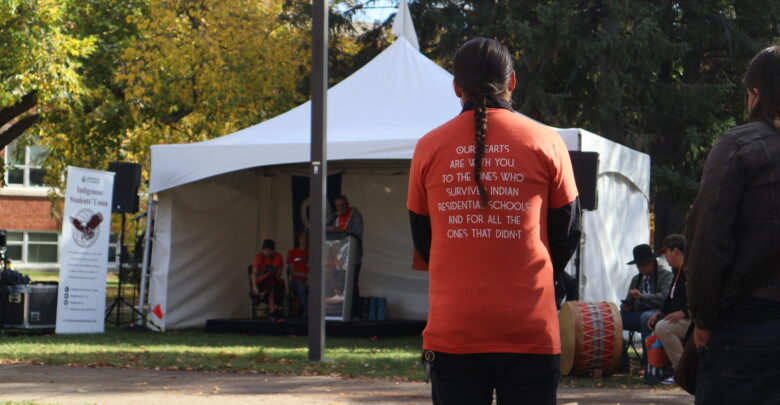 Jonas Smith
Jonas SmithOn September 28, students and community members gathered on Main Quad to attend the third annual residential school memorial. This year, the memorial focused on the path forward to reconciliation and healing.
The Indigenous Students’ Union (ISU) planned the memorial in collaboration with the University of Alberta’s Students’ Union (UASU). Indigenous speakers shared their experiences and knowledge, and Indigenous artists performed near the Sweetgrass Bear.
ISU President Malijha Moyan opens “emotional and heavy” memorial with UASU Vice-president (student life) Michael Griffiths
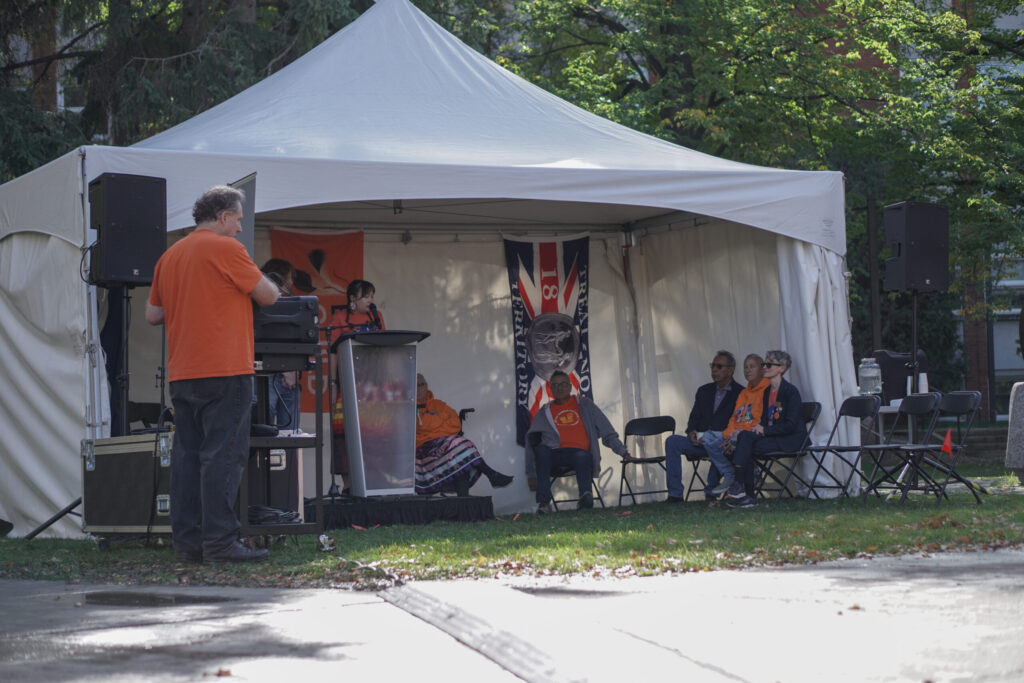
Malijha Moyan is in her second term as the president of the ISU, and is a fourth year Native studies and education student. She is a Cree woman whose family is from Kinuso, Swan River First Nation. Moyan emceed the memorial alongside UASU Vice-president (student life) Michael Griffiths.
Moyan began the memorial by saying it was “emotional and heavy.”
“I hope that this memorial can offer a healing opportunity [for Indigenous people] to come together as a community, and also an opportunity for non-Indigenous people to listen and learn.”
Griffiths gave the land acknowledgement, saying that he was “honoured and privileged to speak … on Treaty 6 Territory.”
“The city of Edmonton, the U of A, and the UASU occupy the stolen land of the forcibly removed Papaschase Cree, in amiskwaciy-wâskahikan, or Beaver Hills House.”
In his introductory speech, Griffiths said that he, the UASU, and the U of A have “benefited from the historic and ongoing dispossession of Indigenous peoples from their land.”
“I have the responsibility to seek the restitution of this land and its resources. I have the responsibility to reflect on and uplift First Nations, Inuit, and Métis voices,” Griffiths added.
At the end of his speech, Griffiths asked those in attendance to think critically on how they can “strengthen the resistance and resurgence of Indigenous people and communities.” He encouraged everyone to look forward and challenge themselves to be better as they commemorate the victims and survivors of the residential school system.
“I am grateful today for the presence of elders, storytellers, drummers, and dancers to guide us along the path of reconciliation and lead us in healing.”
“We had to learn how to be responsible for ourselves, for our own government, and for the people at large in our community,” Treaty 6 Grand Chief says
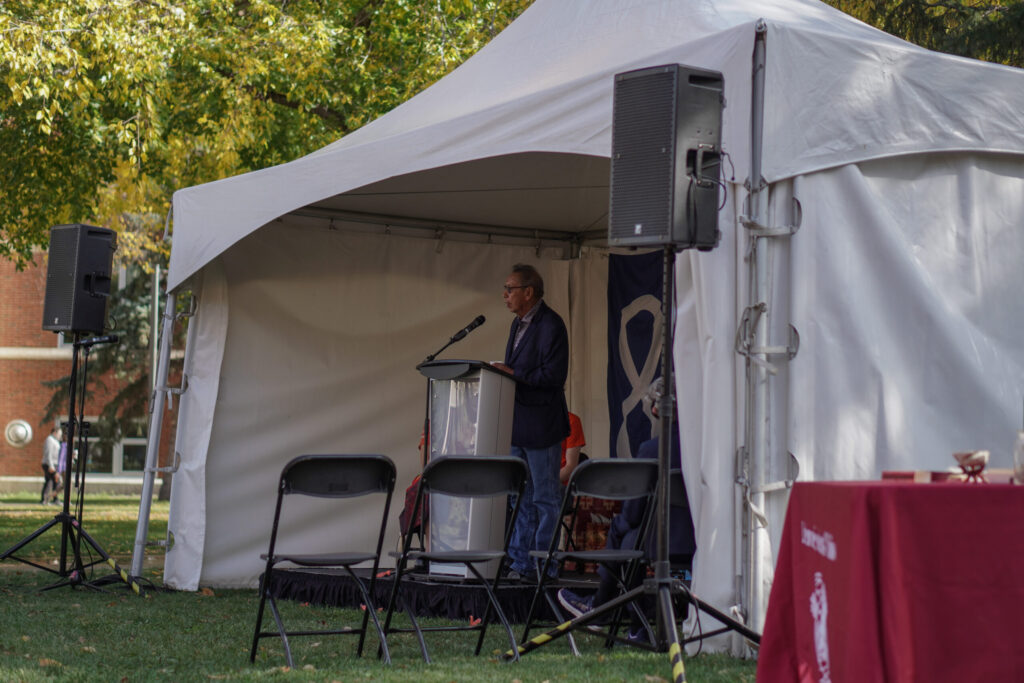
Grand Chief Leonard Standingontheroad was the next speaker. He became grand chief of the Confederacy of Treaty Six First Nations earlier this year. His goal is to advance health education and economic development. Prior to this, Standingontheroad served two terms as chief of Montana First Nation.
In his speech, Standingontheroad said sharing both the negative and positive aspects of Indigenous history is necessary. By sharing positives with one another, it creates a ripple effect.
Additionally, the memorial brought Indigenous people who are knowledgable about the past and used their “education to overcome … all the emotional hurts that they carry,” which he said he felt honoured to be a part of.
Standingontheroad also reflected on his own educational journey. Before becoming grand chief, he worked as a water plant operator. However, before he could enroll in the program, he had to pass his General Education Development tests (GED).
“I had to put my mind to it to pass, because I needed that job to survive. And I made it.”
Elected to the Montana First Nation council in 2005, Standingontheroad began his leadership career. In 2008, he ran again. Finally, in 2017, he ran for chief in a community election and got the position.
“That was the scary part,” Standingontheroad said. “As a chief, you’re responsible for people.”
Standingontheroad’s leadership is based on three tenets: results, relationships, and responsibility. He said that these three tenets interconnect. By communicating his ideas, Standingontheroad achieved the results he wanted, which helped him establish relationships. Those relationships then allowed his people to improve their skills and capabilities.
“But most of all, we had to learn how to be responsible for ourselves, for our own government, and for the people at large in our community.”
Standingontheroad connected this back to the students in attendance.
“If you follow those three R’s, the world is your oyster. It will take you places in whatever discipline or degree that you’re pursuing. It will open up doors for you.”
Elder Dr. Leona Makokis recounts surviving Blue Quills residential school as a student, then transforming it as president
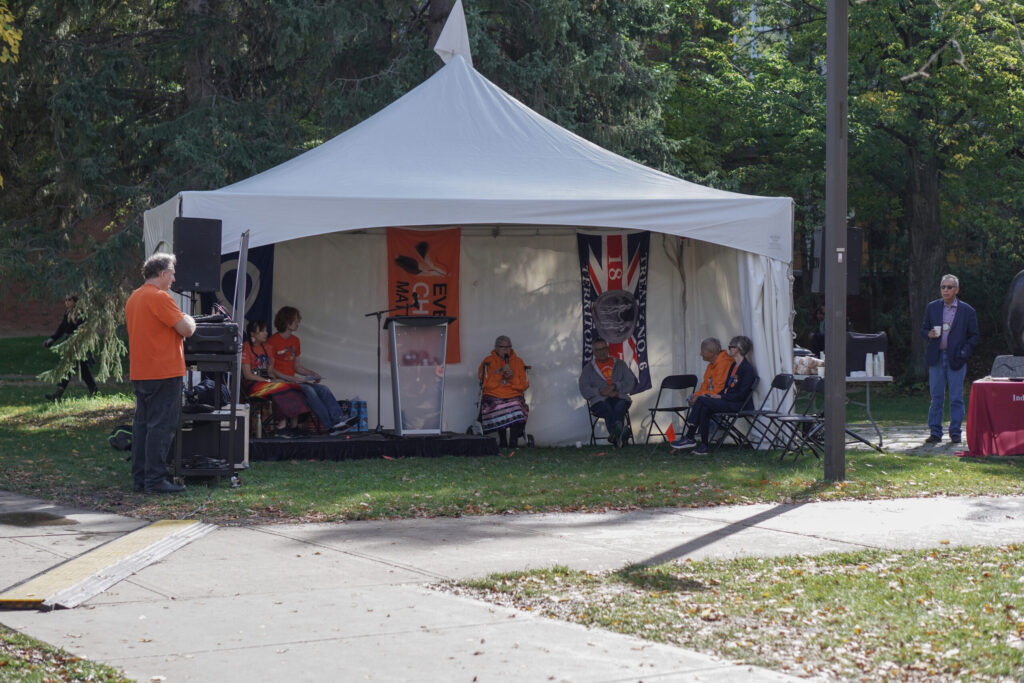
Elder Leona Makokis spoke about her experience as a third-generation residential school survivor. Like her mother and siblings, Makokis attended Blue Quills (Sacred Heart) Residential School in St. Paul, Alberta for nine years.
Makokis said she had regrets about “what did not take place” when she left home to attend the residential school. Because she was “gone ten months of the year,” her relationships with her family were underdeveloped. As a result, Makokis did not learn Cree until she was an adult.
“I’m still on this journey of learning our creation and ceremonial stories. They are the foundation of who we are, as is the language,” Makokis said.
In 1970, when the Government of Canada announced that Blue Quills was closing, community members from Saddle Lake First Nation occupied the school in protest. A subsequent agreement between Saddle Lake and the federal government turned the school into the first independently-owned First Nations university in Canada, now known as University nuhelot’ine thaiyots’i nistameyimâkanak Blue Quills.
Involved in the takeover of Blue Quills, Makokis’ parents dreamed of a school which retained the Indigenous culture, and what it could mean for the community.
“They said ‘yes, our teachers [and] our children will have the western education. But more importantly, they will come home. They will learn who they are, they will learn their languages, they will be in ceremony, they will be the singers.’ It was so visual, you could feel it. You could see what we could do.”
Makokis got her administration degree from Athabasca University. Later, she came to the U of A and got her Bachelor of Education.
Makokis became executive director of the University nuhelot’ine thaiyots’i nistameyimâkanak Blue Quills in 1982, and then president in 1993.
In hindsight, Makokis said the changes she needed to make to the institution were “so visible.” Because they had spent so long without their parents, residential school survivors didn’t know how to parent, Makokis said.
“We didn’t have our Indigenous way, [and] we didn’t have our language. We forgot about our relationships and the meaning of relationships,” Makokis said.
“Auntie and uncle and cousins [are] just nouns [in English]. In our Cree language, they’re roles and responsibilities. My mother’s sisters were my little mothers and they had the same role [as her]. My dad’s brothers [were] little fathers, so they had the same role as my father. And there was a community. We were a community.”
“You don’t get over it. We were in jail, at children’s jail,” Makokis says
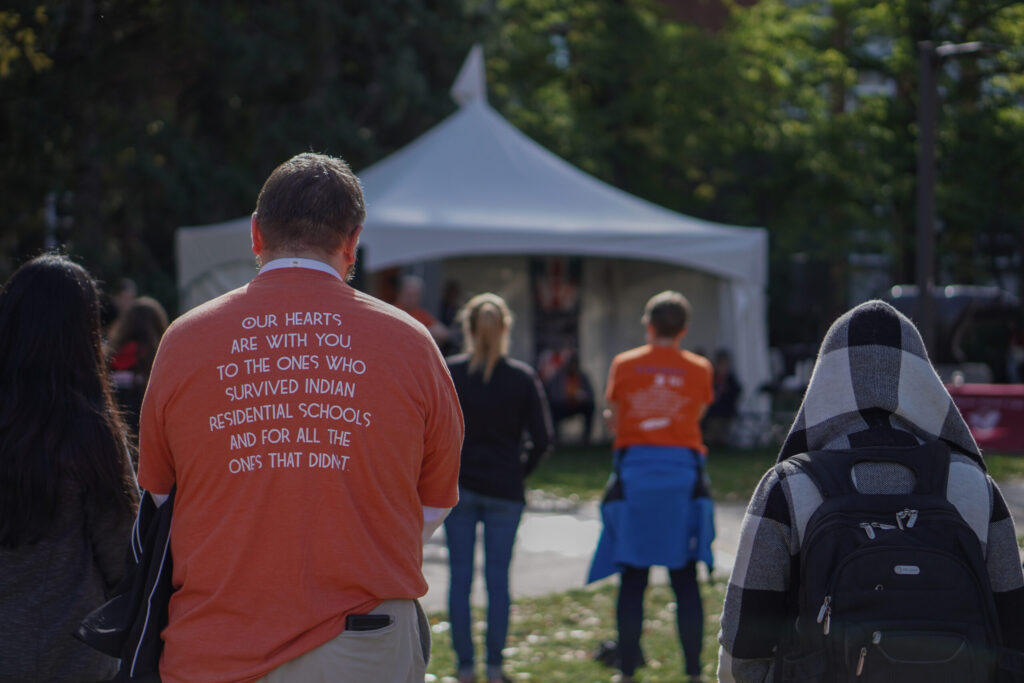
At University nuhelot’ine thaiyots’i nistameyimâkanak Blue Quills, the courses were arranged by other universities and colleges. Makokis met with the staff at these institutions in hopes to change the curriculum, but lacked the authority to do so.
“I was expecting non-Native people to change the curriculum to our thinking, when they did not know what they don’t know,” Makokis said.
This isn’t an insult towards Canadians, since they aren’t taught about Indigenous peoples, she said. Even when University nuhelot’ine thaiyots’i nistameyimâkanak Blue Quills was an operating residential school, people in the area didn’t know it existed, Makokis said.
Ensuring the university represented Indigenous people as an institution drove Makokis to make curricular changes.
“I remember going upstairs in the 90s, and I walked into the board room. One of the board members was sitting there, and he had his eyes closed. As I walked in, he said, ‘when I come here, I want to know, this is our school. I want to smell the sweet grass, I want to hear the drums, I want to hear the songs, I want to hear the language, I want to hear the laughter. I want to see that this school represents us.’”
University nuhelot’ine thaiyots’i nistameyimâkanak Blue Quills today is a “university that’s been guided by those visions [and] dreams of Elders.”
To heal from her experiences, Makokis said she had to unlearn teachings from residential school she had internalized, such as individualism and materialism.
“We’ve been told [to] ‘get over it,’ [and] ‘that happened a long time ago.’ You don’t get over it. We were in jail, at children’s jail. That’s how we were treated. To survive in that place, you had to give up who you [were].”
In her adult life, Makokis has learned more about her Indigenous identity, which allowed her to heal.
“Going to ceremony and learning who I was, and accepting I [have] roles, responsibilities, gifts, and a purpose in life, has directed me. And that comes from teachings from our Elders,” Makokis said.
Elder Louis Lapatak recollects residential school experience: “I still have nightmares”
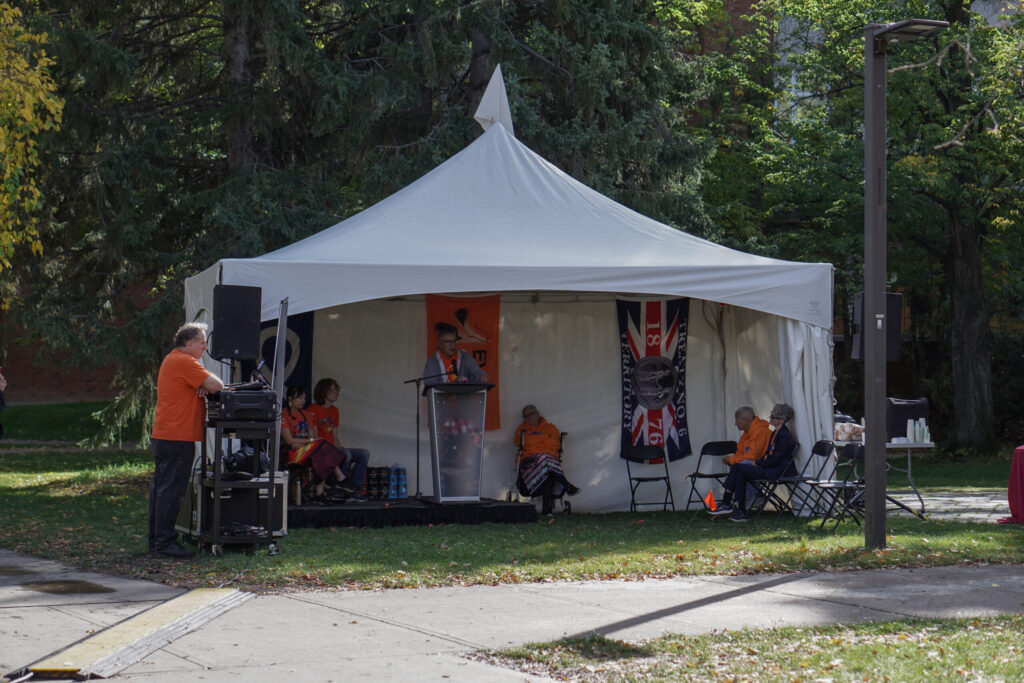
Elder Louis Lapatak began attending Blue Quills Residential School in 1952, at the age of seven. He left the school in 1965, and returned as a Cree instructor.
On occasion, Lapatak gives tours of University nuhelot’ine thaiyots’i nistameyimâkanak Blue Quills. He said there are lots of rooms, and each one has a story. During these tours, Lapatak shares his “recollections of Blue Quills.”
“I don’t speak too well about the priests and nuns, nor the staff of the former Indian Residential School,” added Lapatak. “I don’t have too many good words, [and] I recall the priests and the nuns for what they represented.”
Lapatak left Blue Quills when he was 20, despite the law requiring Indigenous children to attend residential schools until they were 15. This was because he ran away from the school three times and had to repeat the eighth grade. As well, Lapatak’s grandparents raised him and his siblings. But, his grandmother passed away, and shortly after, his grandfather disappeared out of grief. With no guardians, Lapatak said he “had no choice but to stay at the residential school.”
In 1972, Lapatak visited Blue Quills. He noticed that Indigenous icons and symbols replaced the religious iconography displayed in the school.
In 1985, Lapatak returned to study at Blue Quills after his wife convinced him to upgrade. After this, he moved on to other endeavours, but a few years ago, he decided to attend the school again.
“This funny thought came in about three, four years ago — I wanted to go back to Blue Quills, that old residential school. So I did. All I wanted to do was learn how to read and write in Cree … and learn some syllabics,” Lapatak said.
Blue Quills staff members encouraged Lapatak to continue his education in the Cree program. He then got his master’s in Indigenous languages, and is now teaching there.
However, Blue Quills still impacts him. Lapatak continues to have nightmares about his experiences at the residential school, he said.
“The other night, I dreamt about two survivors. They were stuck someplace. Their faces were ugly. I suppose they need help, they need our prayers,” Lapatak said. “I talked to an elder and I gave him some tobacco to help me have better dreams, or no dreams at all.”
“Sometimes I talk to these people I dream of, even priests and nuns. I tell them to go away, go on your own, help your own selves — leave me alone.“
“Have we been taught the truth? Are they just partial truths?” Elder Colette Cullen questions
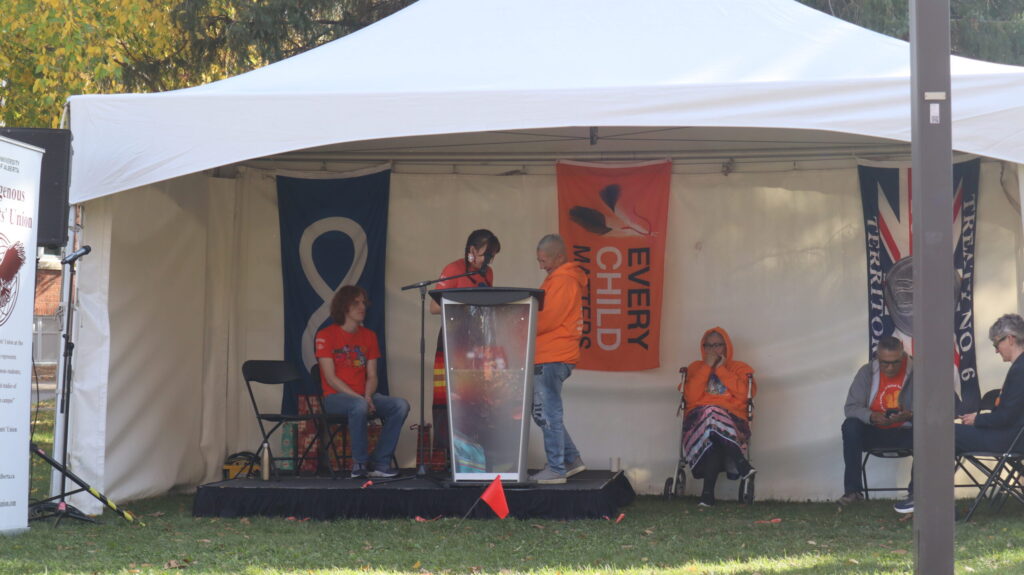
Elder Colette Cullen, a mixed Cree woman from Treaty 8 Territory, took a history class on residential schools in winter semester. She called the experience “profound,” and said that it invoked many emotions between herself, her classmates, and her professor.
“It may have been one of the most important classes I’ve ever taken in my career as a student and as a human being,” she said. Cullen recited a poem she wrote in the class titled “Voices.”
“Build your schools, talk your talk, and tell your lies, because we are still here. We have always been here. We know that you know, we will always be here. And that, sir, is voice and truth. We know that you know.”
Cullen spoke about the unmarked graves of thousands of Indigenous children who attended residential schools.
“We stand on the grounds of an institution that is recognized throughout the world in a country that is seen as benevolent, but we need to reflect on what that means. Truly reflect. Have we been taught the truth? Are they just partial truths? Or [are they] inconvenient truths that cannot be ignored anymore as we continue to find our little ones that never came home.”
Cullen said that the National Day for Truth and Reconciliation is an opportunity for every Canadian to reflect on what built Canada.
“With every child we find — over 10,000 now, and growing — we do have great reason for reflection,” Cullen said.
She said that these are uncomfortable truths and often hard to accept. However, the truth also “unites us as a nation.”
“[It] brings us together to dispel anger and despair, and [instead] embrace justice, harmony, and trust.”
To Cullen, reconciliation is an ongoing process and a “way of life.” She said that reconciliation is about learning from experiences, understanding one another, and creating spaces for people to heal.
“It is planting seeds of hope and respect, so that all of our children feel the growth and love. [And] that we all bloom and thrive together. This for me is reconciliation. This for me is truth.”
“There is no equity [or] justice without truth,” Dr. Carrie Smith says
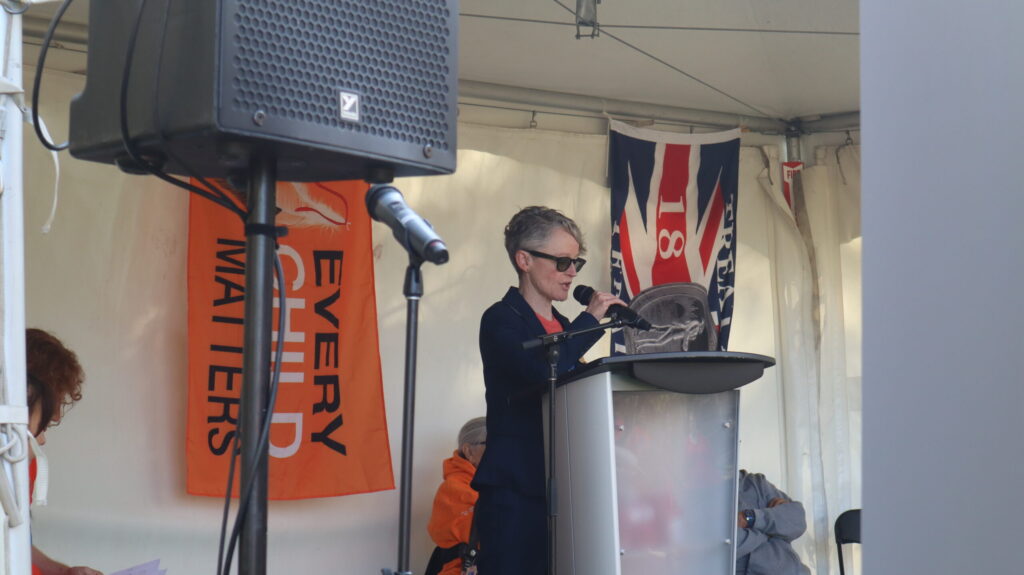
The final speaker, Carrie Smith, vice-provost (equity, diversity, and inclusion) (EDI) acknowledged that she engages in equity work within the context of a colonial past and present.
“The role I play here at this institution is in EDI. There is no equity [or] justice without truth,” Smith said.
“At the heart of all equity work is the recognition that structurally embedded injustice exists, including in and through colonial structures. All equity work undertaken by those of us who are settlers on these lands in these places we call Edmonton, Camrose, Alberta, Canada must always attend to colonial systems that persist and engage in actions and activities that serve to dismantle [this injustice].”
Smith said that the U of A “is committed to the journey of truth,” and embraces “measures to strengthen Indigenous identity, languages, cultures, and worldviews in our classrooms, in our labs, in our hallways, in our rooms in our conversations together — individually, and as a collective.”
Smith added that the U of A commits to learning the truth about the impact post-secondary systems have had, and continue to have, on Indigenous families and communities.
“I’m hopeful here when I see the students collecting to learn and to come together, and be in this space of celebration and story.”
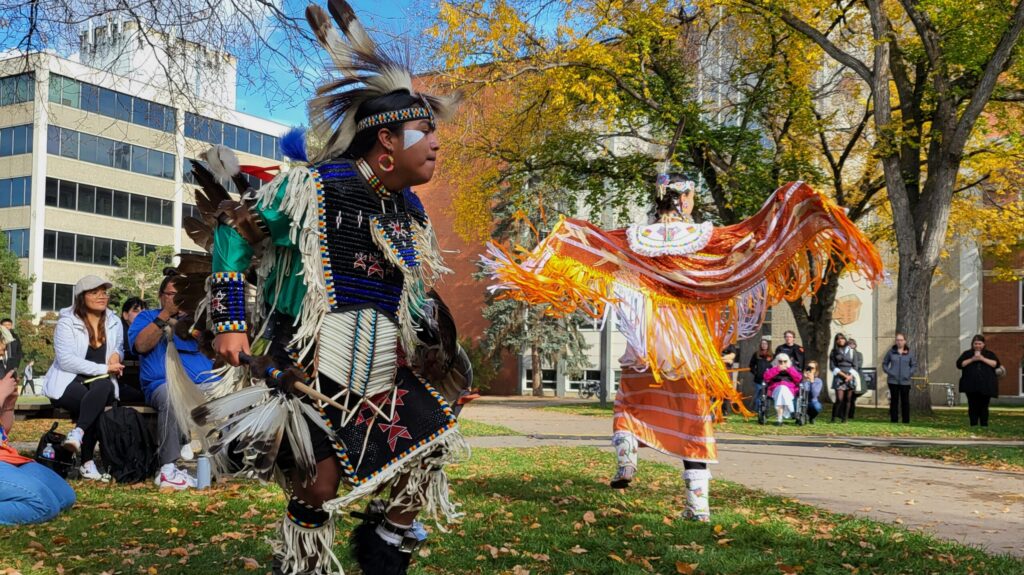
Lastly, the drum group Kihew Asiniy from Saddle Lake First Nation performed an honour song. Afterwards, dancers Hailey Hamelin Wilson and Jaice Washington performed a jingle dance. As the memorial closed, speakers received honorariums.




